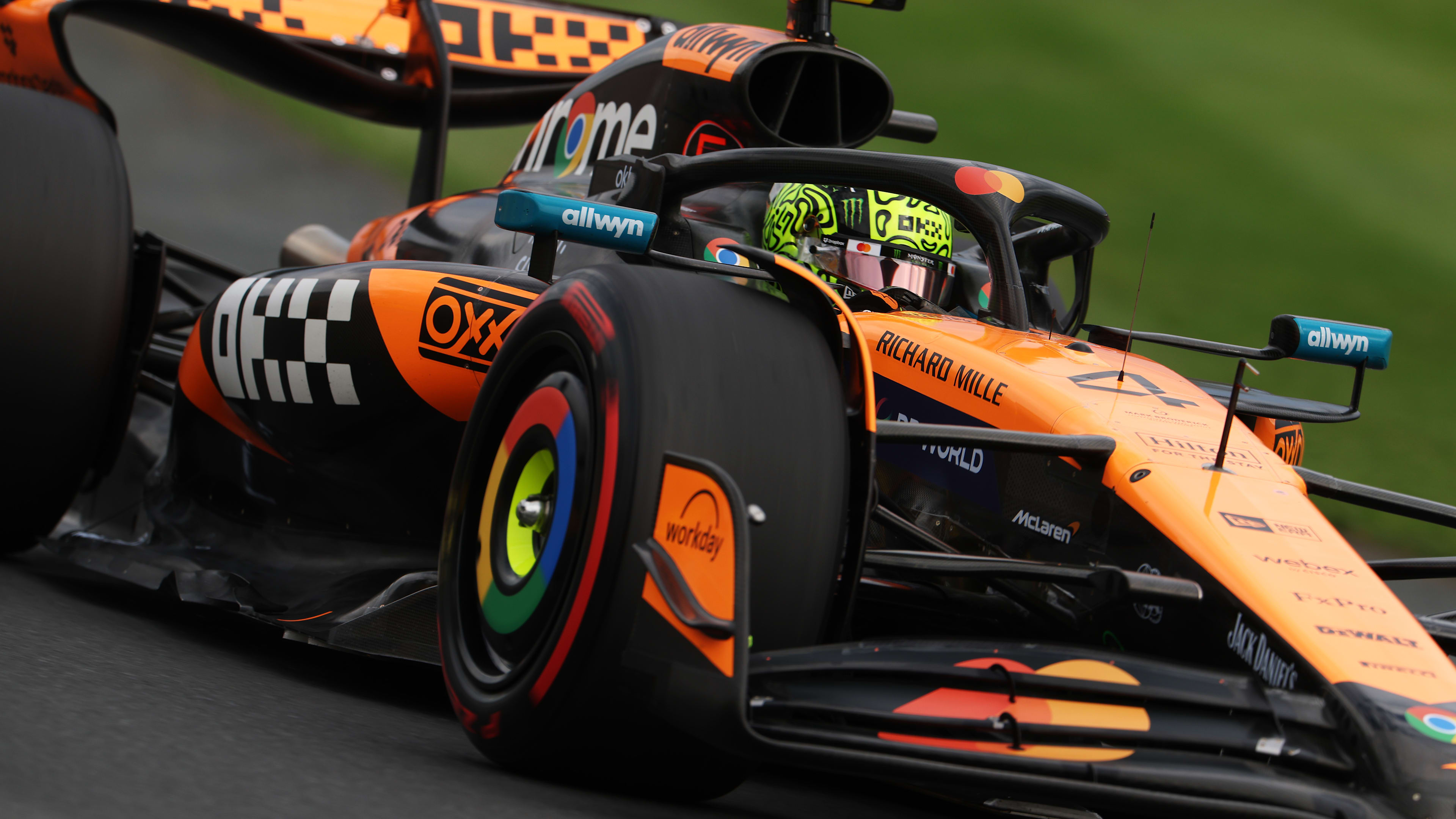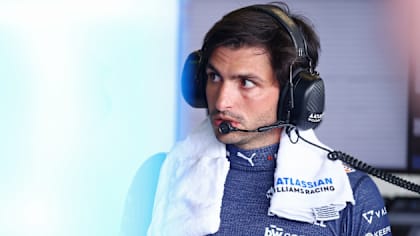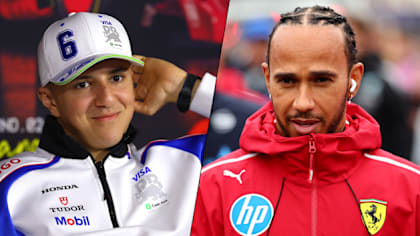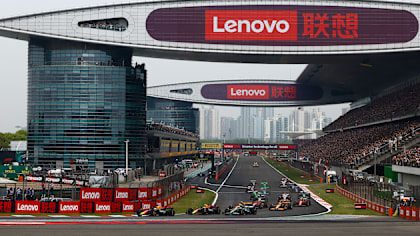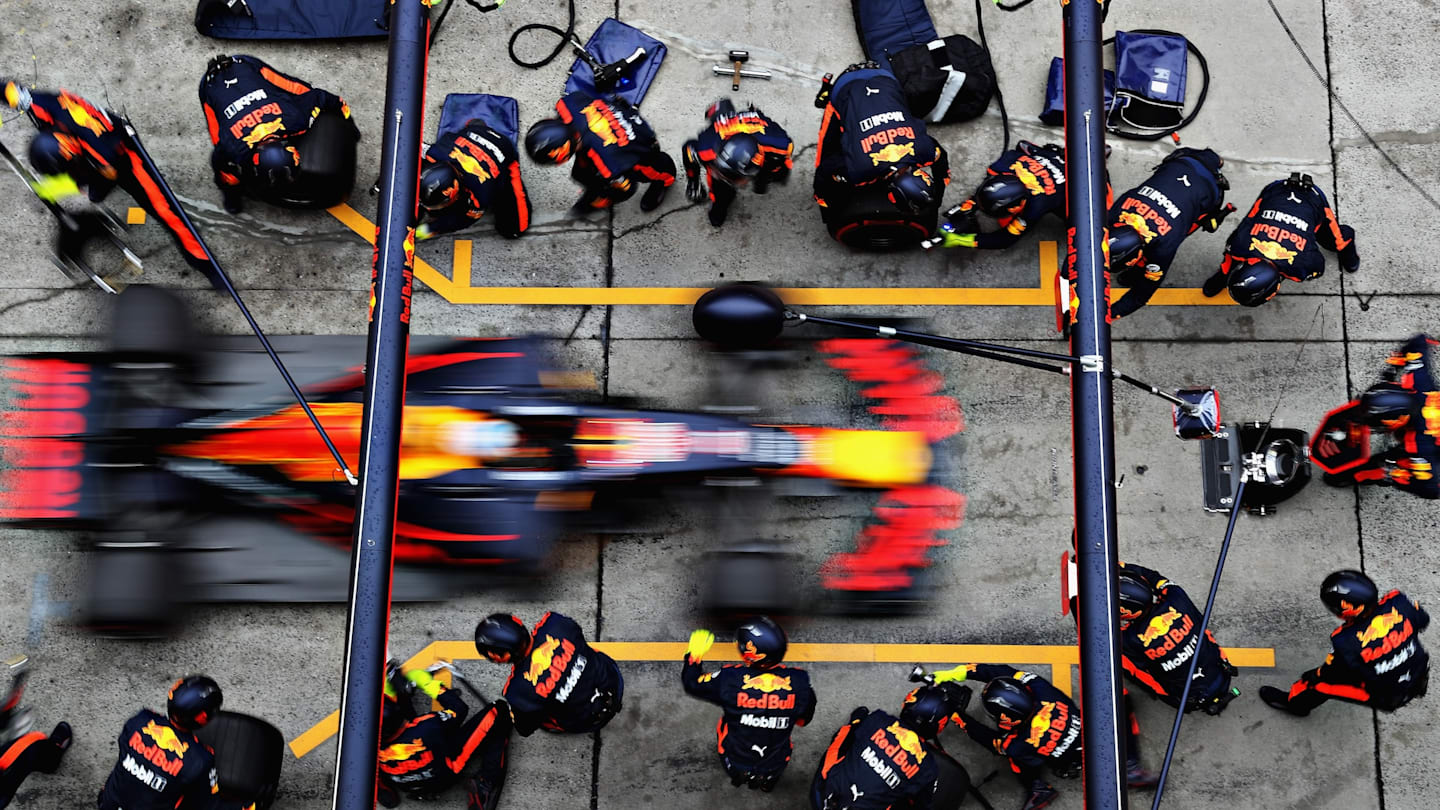
Feature
Anatomy of a pit stop: How do F1 teams service their cars in less than two seconds?
Share

Spend enough time witnessing them, and a good pit stop becomes something you hear, rather than see. During a good stop – between 2.2 seconds and McLaren’s World Record 1.80s – you hear just two sounds: the first is four wheel guns firing in unison to unscrew the nuts; the second is them firing again to fasten the new nuts onto the axle.
Lengthy pauses, or guns out-of-sync is the sound of a stop going wrong – but those are increasingly rare. Pit stop standards in modern F1 are very high. So how does it all work?
MUST-SEE: Get an enticing behind-the-scenes look at Apple Original Films' upcoming 'F1' movie
Calling the shots
A driver doesn’t – or shouldn’t – make the decision to pit. A strategy group is almost always better placed to see the bigger picture.
They’ll take driver input on board and there are caveats: the driver may make the decision in low grip conditions – calling themselves in when they feel the track is getting too wet for the tyre they have, and operational control will often be passed to the race engineer or driver, particularly when a stint is being extended, and the driver is asked to stay out for as long as he thinks the tyre are working.
There are also ‘box-to-overtake’ instructions, where the driver is asked to do the opposite of whatever the car in front does – stay out or come in – and the opening of Safety Car windows. When the window is open, the car will pit if the driver sees a Safety Car notification, cutting out a vital second or two of dialogue, if the notification comes as the car approaches the pit lane.
Get ready
Pit stop operations are run from the pit wall, usually by the sporting director, team manager or operations director. They will call the pit crew out into position, and give instructions on which car, which set of tyres, and by how much the front wing should be adjusted. They’ll then supply positional updates as the car goes through various corners and enters the pit lane.
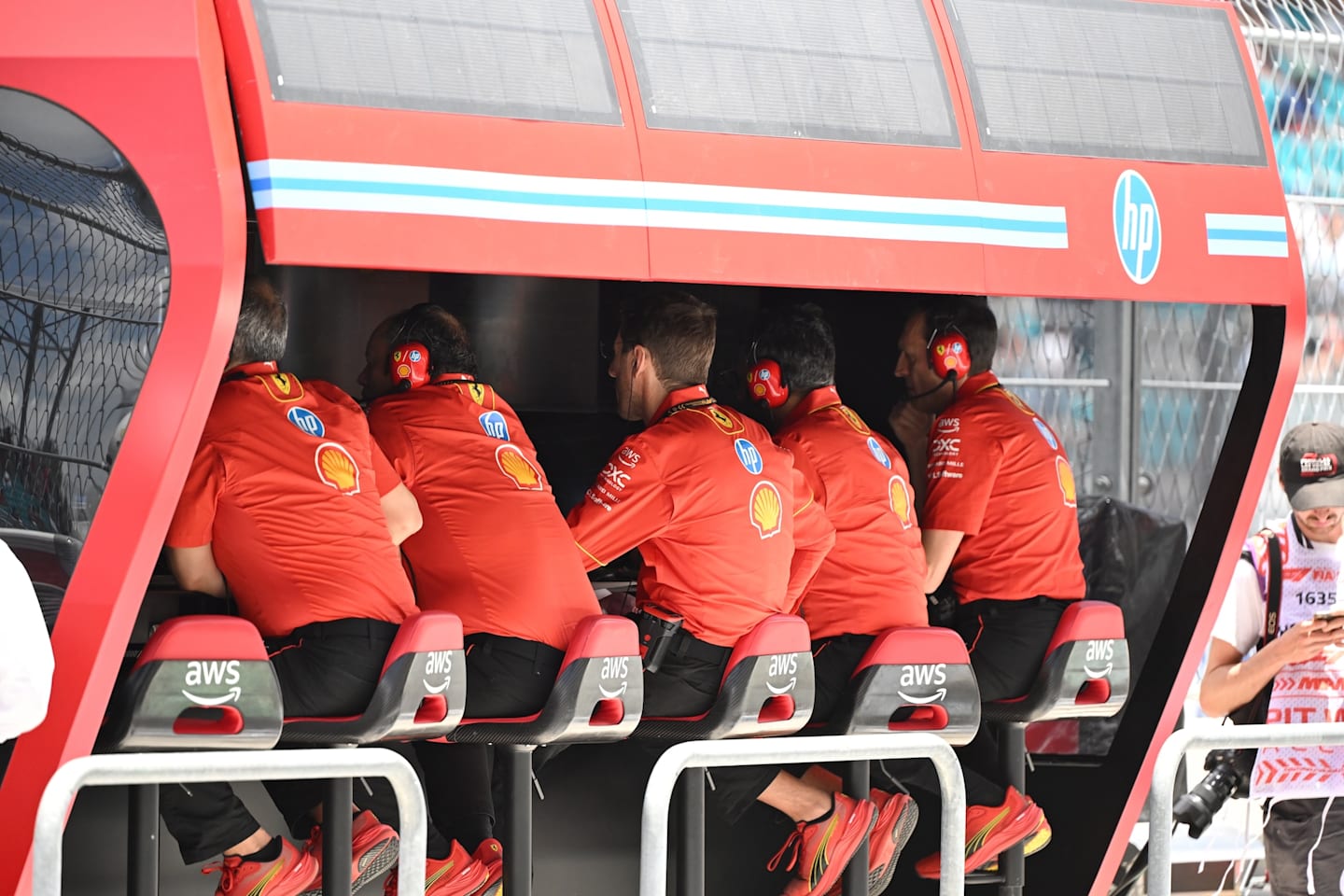
The team on the pit wall will usually make the call as to when the driver will pit
Once the crew know the car is coming in, they get into position. This is ideally 15-20 seconds before the car arrives, and they will get out the wheels and check the prime and spare guns. The seat each individual has in the garage is chosen to minimise collisions during this preparation.
The front jack
The DHL Fastest Pit stop Award judged ‘Fastest’ on the stationary times each crew achieves – but watch closely, and the entire pit stop begins before the car halts, with the nosecone hitting the carbon-fibre front jack a tenth of a second earlier.
WATCH: F1 for beginners – Everything you need to know about F1
The jack operator absorbs the momentum while lifting, and that’s when the clock starts running. In a solid 2.2s stop, the front jack will be fully engaged at 0.3s. By 0.8s the jack operator will engage the swivel and begin to step to the side – the better to allow the car easy egress.
1.6s into the stop the front jack operator is out of the path and ready to press the quick-release button that drops the car. That’ll happen at around 2.1s, with the jack still swinging through its arc when the car departs.
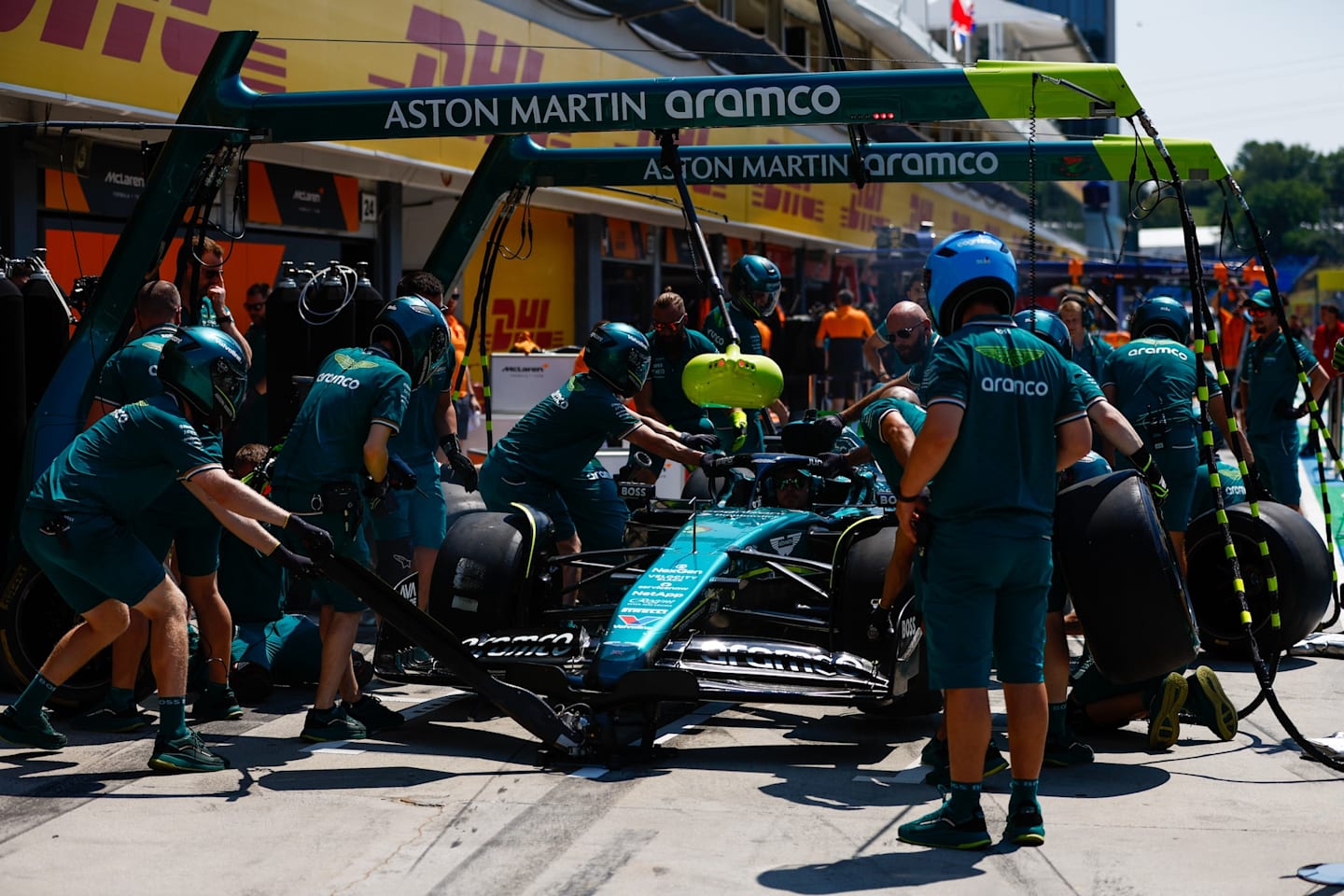
The front jack operator has to step off to the side of the car before the stop is complete
The rear jack
The rear jack operation comes a little behind the front jack, simply because the operator can’t move into position until the car has passed – but they’ll already be in motion before the car hits the front jack. Key to a good stop is getting the rear jack’s cup onto lifting point at the first attempt.
It’s a job for one of the stronger members of the team: the modern cars are heavy and, with ground-effect aerodynamics, they run very low, meaning there’s less mechanical advantage to work with around the pivot, and more force required. The rear of the car will be up about 0.4s into the stop, and drop at 2.1s.
WATCH: From understeer to degradation – How to talk like an F1 driver
The four corners
The meat of the pit stop is performed by the wheel-change crews. Superficially, all four corners of the car look the same, but there are differences between front and rear, and even between left and right.
The rear wheels, being larger and heavier, require more strength and leverage to manoeuvre, while the dished wheels with recessed nuts mean the gunners have to wait until the car is stationary before starting to move – unlike the front wheel gunners who will lead onto their wheel before the car stops.
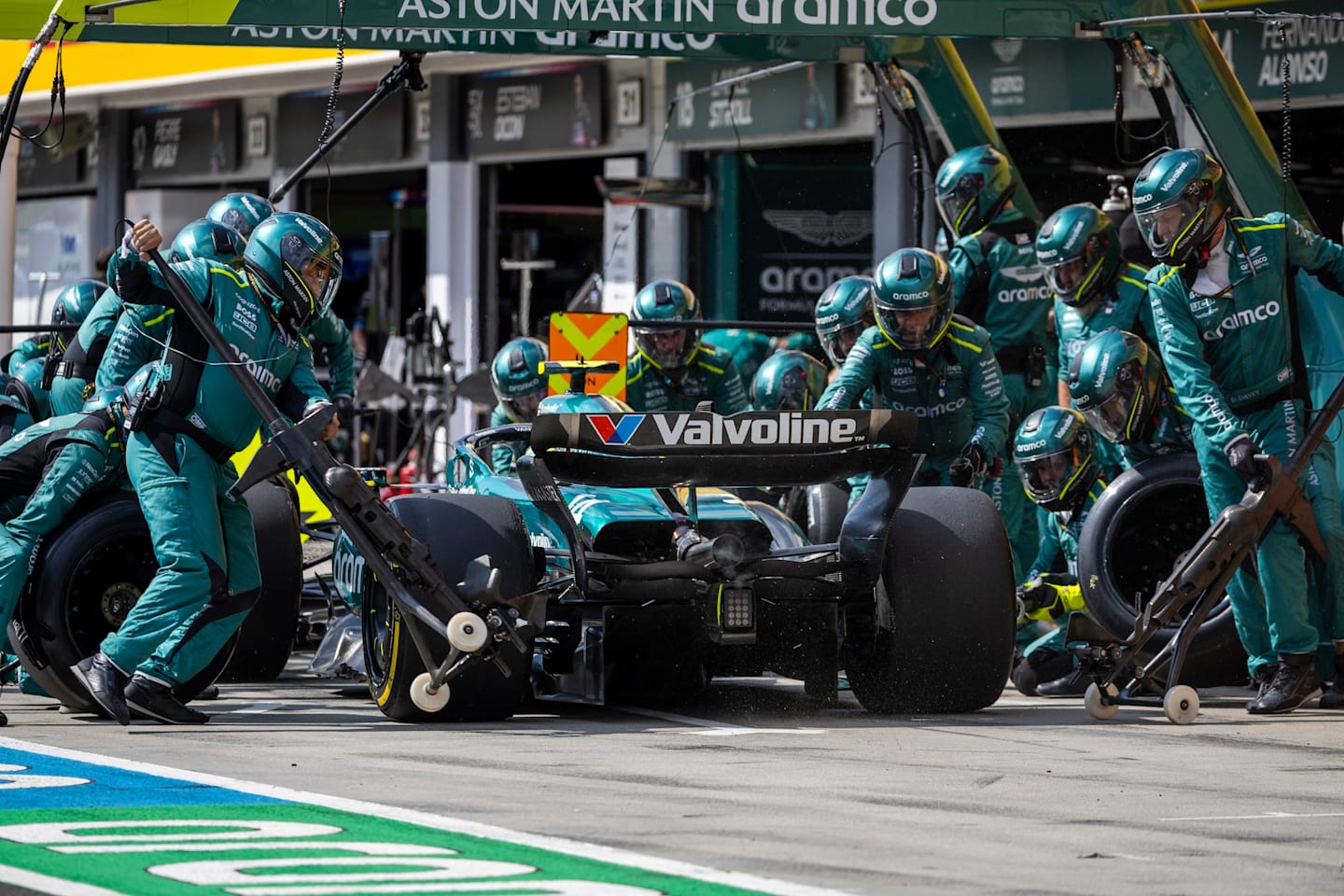
The rear jack man runs in from the left, but note the back-up rear jack man standing by on the right of the shot
The wheel-off crew member, in front, will grip it as the car halts, almost simultaneously with the guns engaging – which happens while the car is still on the ground. The wheels should be off at around 0.6s – usually the fronts fractionally ahead of the rears.
The gunner needs to keep the gun on the old wheel until it is clear of the axle, holding down the spring-loaded retaining clips that keep the wheel on the axle.
READ MORE: The beginner's guide to F1 pre-season testing
The wheel-on crew member, from behind, is moving the new wheel into position at the same time, and 1.2s into the stop, the new wheel is fitted. The guns automatically reverse direction, and 1.4s into the stop, the gunners get back onto the captive nut. Around 1.9s into the stop the guns come off, confirmation buttons are pressed, and the car is ready to go.
The garage-side gunners have a slightly easier time of it, as they’re able to see the car approaching, while the trackside gunners have to rely on a tap from their team-mates as the car approaches from over their shoulder.
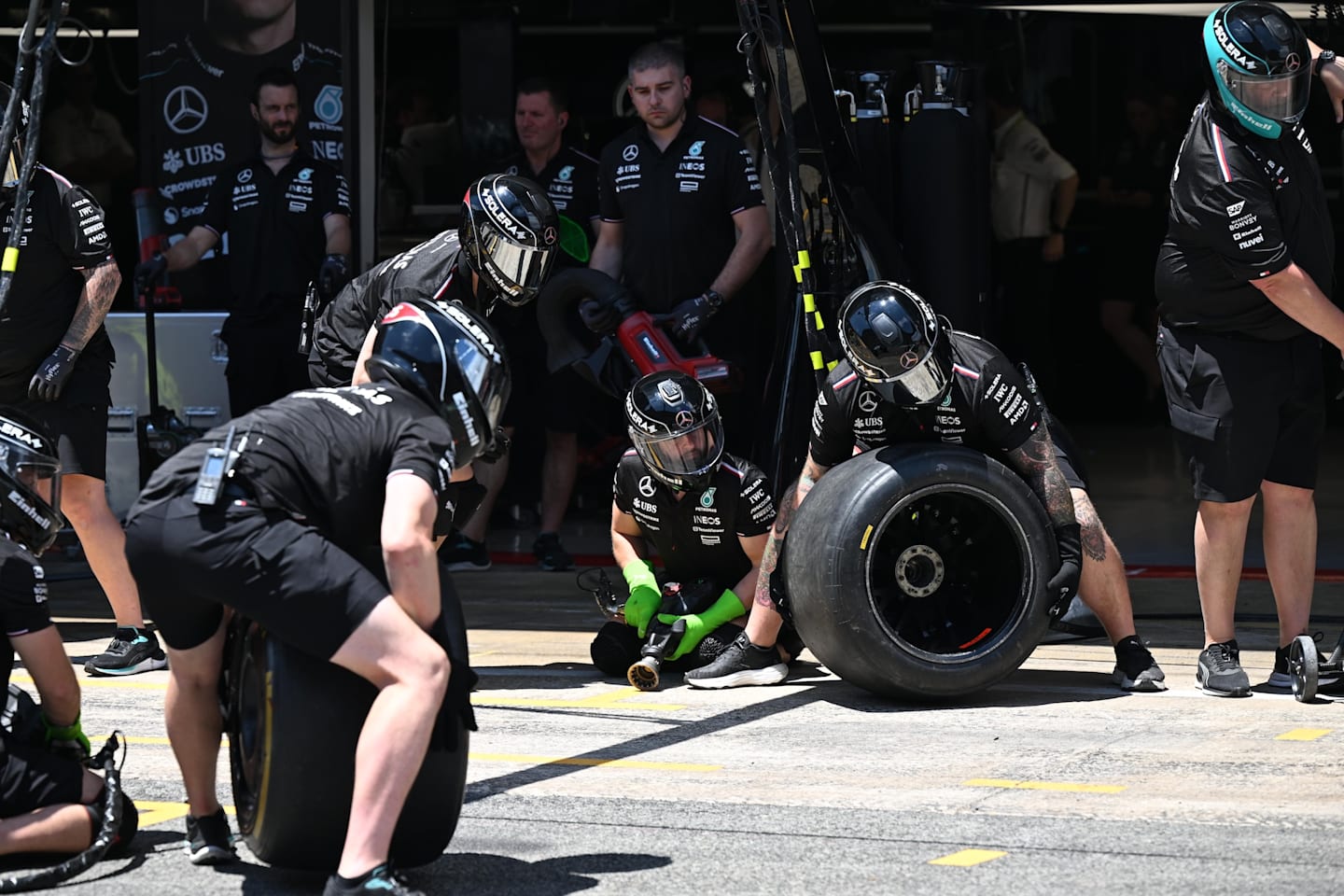
The wheel-change crews wait for the car to arrive
Who actually does the work?
Pit crews aren’t specialists: they’re drawn from the ranks of the team’s mechanics and technicians, and so the team selects a crew from the best people it has available – but certain traits lend themselves to certain positions: while front jack operators tend to have a heightened fast-twitch response, wheel-gunners are usually the calm centre of the operation.
They will have to deal with the unexpected, whether that’s a car out of position, a misfiring gun or a stuck nut.
READ MORE: The beginner’s guide to F1 penalties
Ancillaries
The other active part of the stop is a front-wing adjustment. The wing-winders on either side pre-set torque drivers to move the flap-angle up or down. The pit-crew also features two stabilisers. They grab the airbox and radiator inlets on either side to steady the car, usually getting hands-on just before the car comes to a halt, and releasing it when the car is dropped.
Teams work hard to make sure they’re doing as little as possible. One of the tasks involved in crew selection is ensuring a degree of balance between the four corners.
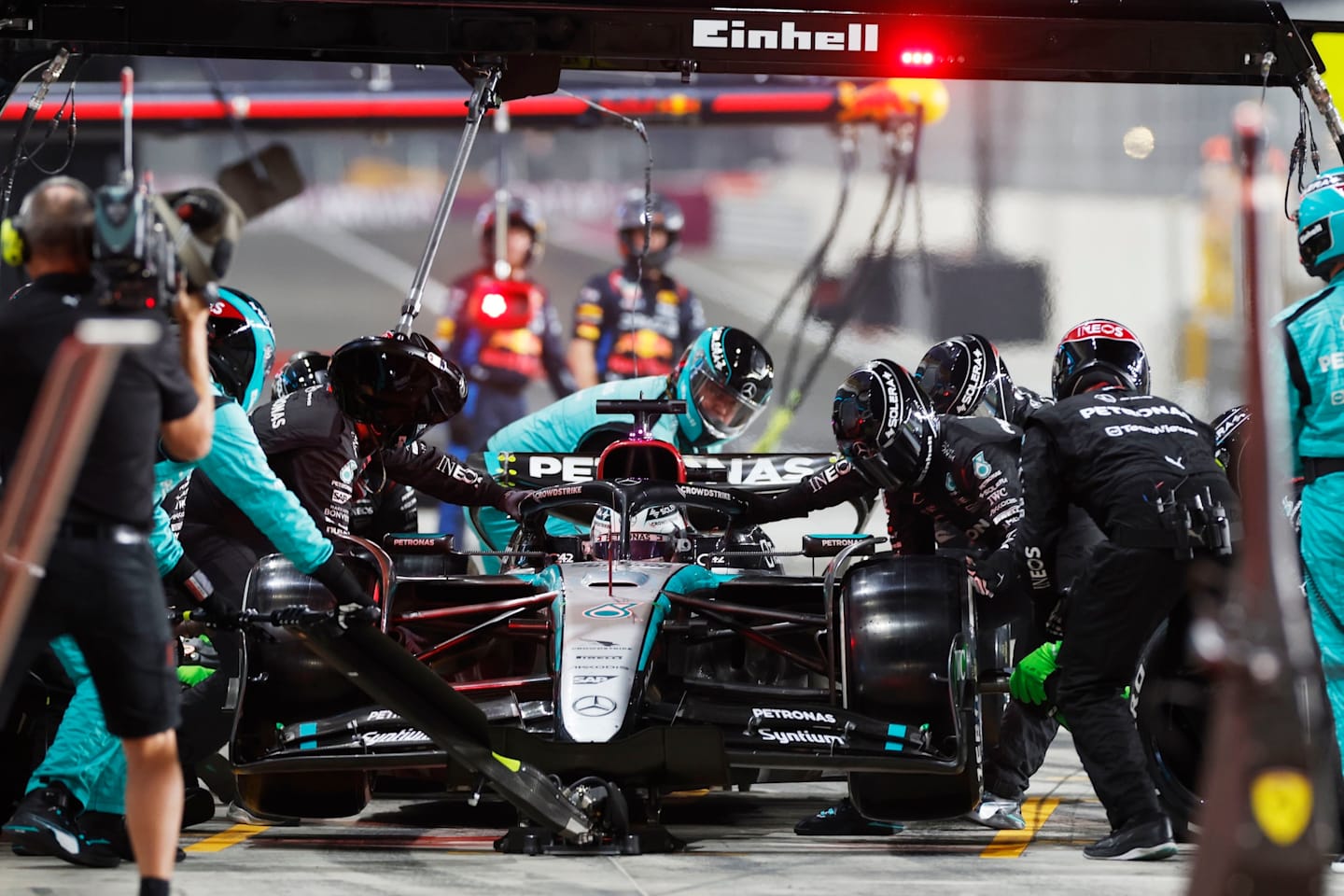
Note the two crew members holding the car steady
Just as the crew are assigned positions for handedness, there’s also a desire to ensure everything is operating at the same speed: if the crew on one side of the car is regularly quicker than the other side, that tends to throw the car off-balance, and slows things down.
The stabilisers have perhaps the most variable job in a pit-crew: alongside holding the car steady, they’ll also be responsible for wiping the drivers’ visor, performing a steering wheel change if necessary, clearing debris from radiators or, potentially, when the car pits with a puncture or for a nosebox change, operating the side-jacks.
READ MORE: The beginner’s guide to F1 flags
The crew chief
Every team uses a traffic light system for their pit stops, the old lollipop long having been made redundant by the semi-automated system of lights. The go/no-go decision remains in the hands of a human, with a senior member of the team – usually the chief mechanic – responsible for operating the lights and releasing the car.
They’re getting confirmation lights from the gunners, via the gantry, confirming the correct torque has been applied to the wheels; they’re looking around the car to make sure everything that needs to happen has happened, and finally, they’re looking down the pit lane to ensure their car has space to exit the box safely.

The old lollipop has now been replaced by a traffic light system
This final part tends to be contentious, with ‘unsafe release’ being a frequent cause of penalties (as you can see in the clip below). In theory, the system is simple: each team will have placed a marker on the pit wall guardrail a suitable distance upstream of their pit box. If a car is forward of the marker, the crew chief doesn’t release the car.
This becomes complicated in a high-pressure situation where a split second can make the difference between being ahead and behind. There’s also the situation in some of the more ‘cosy’ pit lanes where a neighbour’s box is located inside your comfort zone.
READ MORE: The beginner’s guide to F1 tyres
The final component
Ask the 10 teams how many people are involved in a pit stop, and you’ll likely get ten different answers. We’ve gone through the active members of the crew, but to this you have to add spare jack operators on standby, and crew standing-by with fire-extinguishers.
There’s often a second crew member with a ‘hold’ authority watching the rear of the car, and then the analysts who will review the stops, the physios who will warm-up the crew, and the medical staff to ensure they’re fit and properly hydrated. The one member of the pit-crew that often gets overlooked, however, is the driver.
2023 British GP Qualifying: AlphaTauri fined for unsafe release in the pitlane
In every great pit stop, the driver needs to stop exactly on the pit box marks. In every good stop, they’re very close. The crews tend to use laser markers on the gantry to position their hands – but that level of precision counts for little if the driver doesn’t stop exactly where he’s supposed to.
The live stops during practice, and the feedback that follows are vital for achieving this level of accuracy.
READ MORE: The beginner’s guide to the F1 weekend
Look closely at the markings on the pit box, and you’ll often see scales, allowing the crew to judge during practice by how much the driver is long or short, left or right, or skewed. Some drivers like this information to be relayed instantly, others will wait for a debrief, when the practice stops will be discussed.
They’ll also discuss the approach to the box and how easy it is to spot, and sometimes the angle at which the box is laid-out. Each team has an assigned position for their pit box, but the teams have some wiggle-room to change the angle. (While the box is usually nose-in to the garage – because it’s harder to get in than get out – the tighter the pit lane, the steeper that angle.)
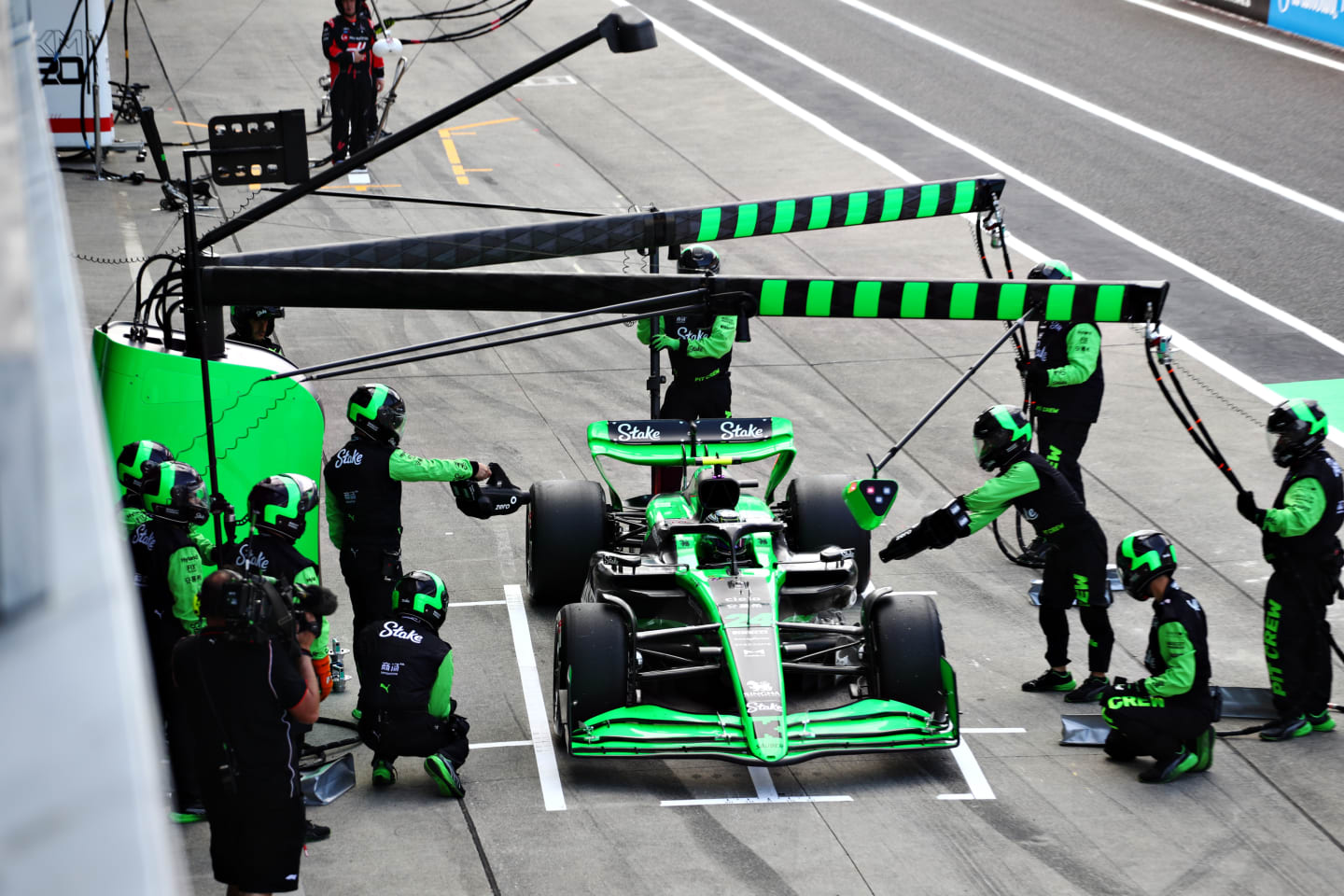
Note how the Sauber pit box is off at an angle compared to the pit lane itself
Top teams go faster
Looking at the DHL Fastest Pit stop award table, it tends to mirror the Constructors’ Championship standings, in that teams with fast cars usually also do the best pit stops. This isn’t a lack of effort or a talent deficit from the backmarkers, simply the consequence of how teams choose to spend their budget.
Improving pit stops is an expensive business. It requires design teams constantly refining equipment, factory mock-up gantries and electric mule cars, motion analysts, pit-crew physios and state-of-the-art factory gyms.
READ MORE: The beginner’s guide to the F1 calendar
For a team at the wrong end of the field, quicker pit stops will shave a couple of tenths off their race; but shunting that money into aero development might shave a couple of tenths from every lap, and thus, is a much better use of resources.
That becomes less true at the sharp end of the grid where pit stop performance might be worth positions and points.
DHL World Record Fastest Pit Stop – Qatar Grand Prix
Practice, practice (but not too much)
Pit stop practice over a race weekend comes in two flavours: the teams will do ‘live stops’ when the cars come into their pit box during the practice sessions and then dedicated pit stop practice sessions.
Once the cars are built, the crew will do the latter every day, running through a mix of standard stops, with a few variants thrown in to keep things fresh. In a typical practice, a crew might run through eight or 10 iterations – rarely more than this, for fear of leaving the crew fatigued or jaded.
READ MORE: The beginner’s guide to the F1 Sprint
Typically, the work being done at the track is merely to keep everyone sharp – too much practice is just as bad as too little. It’s worth noting that, when McLaren did their World Record 1.80s stop at the 2023 Qatar Grand Prix, they did so on a weekend with much-reduced pit stop practice, the team avoiding the energy-sapping heat out on the apron.
Quarterbacking the stop that day was Charlie Hooper, McLaren’s Operations Director, seated on the pit-stand. “We have a standard layout of pit stop practice throughout a race weekend … however, this plan is reviewed at each event depending on various factors like ambient temperature,” he says.
“We will look to see if we need to reduce or increase stop numbers depending on crew fatigue or if we have new crew members that weekend. At events … with high temperature and humidity, for example, we will likely reduce stop numbers over the weekend.”
Hooper’s reference to ‘new crew members’ is an interesting one in the modern era where teams are now practicing a degree of rotation in their garage to cope with the demands of a longer season, more flyaways and a greater preponderance of triple-headers.
READ MORE: The beginner’s guide to the F1 Constructors’ Championship
In the past, standard practice would have been list of direct replacements on ‘B' and ‘C’ teams, but current thinking is a little different. With many members of a pit-crew rostered to miss three or four races, the subs’ bench is seen less as an unavoidable expediency, and more as a performance-enhancing opportunity, freshening-up a crew, rather than weakening it.
“We have a much larger squad of pit crew members than we did two to three years ago, to enable us to rotate team members in and out of races to ensure the season is sustainable,” says Hooper. “The majority of the crew are trained-up in multiple positions so, while they may have a prime role, they can also jump into a different position and perform at a high level.”
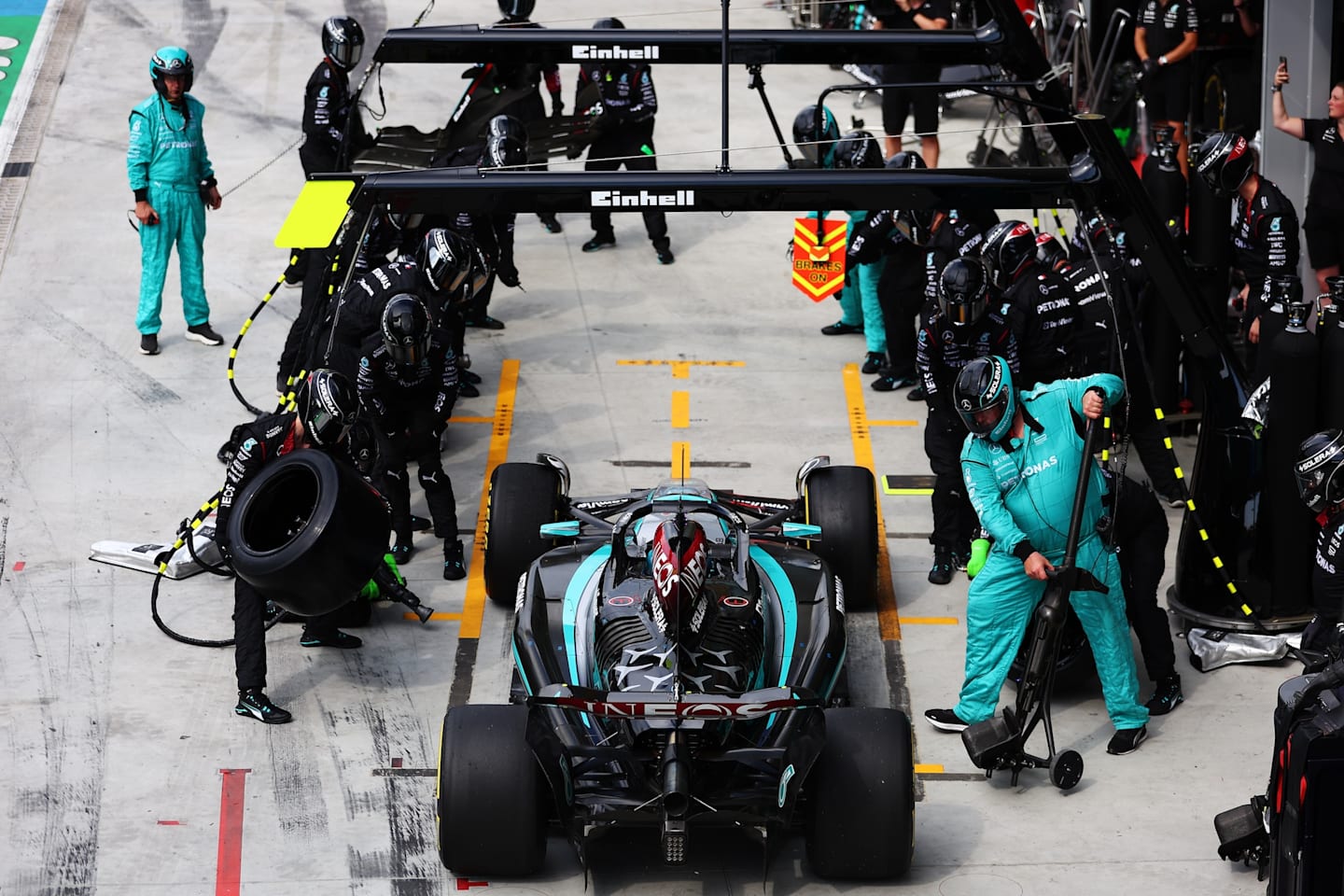
The Mercedes pit crew prepare to leap into action...
Winter prep
The bulk of preparation is done over the winter months: selecting a squad; testing and adapting new equipment; and, of course, plenty of pit stop practice. It’s not something crammed-in around other activities, but rather a carefully-planned development activity.
“Through the off-season, we spend the time just like any professional sports team would,” explains Hooper. “We are continually evolving how we approach the winter break to see how it best suits both how pit stop regulations have changed and how the racing calendar looks. The working group in charge of pit stops set out the targets for the 2025 pre-season before the 2024 season had even finished.
READ MORE: The beginner’s guide to the F1 Drivers’ Championship
“The team will have training sessions and pit stops everyday over the pre-season starting in January building up the squad to enable us to put the strongest team out at each event.
“We practice pit stops but also spend a lot of time in the Optimum Nutrition McLaren Performance Hub with our Strength & Conditioning team, utilising focused training sessions to build up not just strength but resilience to the long season and the physical impact pit stops put on the body.”
Over the last few years the cars have become heavier, the wheels larger and more safety cut-outs have been introduced into pit stop operations – but still stop times have fallen. While some of those improvements still come from equipment development, it’s these human factors that are responsible for the last few tenths.
What are those tenths worth? An excellent pit stop isn’t going to gain a place over an industry-standard good stop – but the combination of a good in-lap, brilliant stop, good out-lap might just do the trick.
More often though, the advantages of having a crew operating at the highest level of performance are, for the front-running teams, strategic. Everyone calculates their own pit-loss time during free practice, and keeps that number as a closely-guarded secret.
READ MORE: Everything you need to know about F1 – Drivers, teams, cars, circuits and more
The team that reduces that number by a couple of tenths with consistently good stops perhaps opens a pit-window (to get out ahead of a midfield scrap) a lap earlier, or introduces more flexibility around an under- or overcut. Rather than the ability to break records, it is this consistency that is more highly-prized.
“It’s no-good breaking a world record if the next pit stop is five seconds!” says Hooper. “We make it clear to the crew that meeting our consistency targets set out at the start of the year will ultimately lead to the best on track performance for the team.
20 times F1 pit stops went wrong
“Reviewing and eliminating the errors seen during practice stops means the crew go into the race in a strong position and are not chasing records. If the crew trusts in their performance and follows the processes laid out, the fast and consistent stops will come.”
You can’t really distil a title race down to an individual moment, but the final race of the 2024 season provides an ample illustration just how crucial a good pit stop is.
In Abu Dhabi, on Lap 25, Carlos Sainz pitted, attempting to undercut Lando Norris. Norris responded on the following lap. Get it wrong, McLaren lose the lead and likely the 2024 constructors’ championship; get it right, and Norris retains a slender lead over the scarlet Ferrari.
It’s the most immense pressure for a crew acutely aware their team hasn’t been champions since 1998. Norris hit his marks, the McLaren crew serviced the car in 2.07s, and he hammered out to retain the lead, take the victory and, with it, secure the title. It was the fastest stop of the day – though you don’t need a stopwatch to know it’s good: you can hear it.
ENJOYING F1.COM? TELL US MORE
Whether you're loving the F1 website and app, or there are changes you'd like to see, we want to hear from you. Take our two-minute survey now...
DISCOVER MORE...
IT'S RACE WEEK: 5 storylines we're excited about ahead of the 2025 Chinese Grand Prix
POWER RANKINGS: Who tops our first leaderboard of the season after a wet and wild Australian GP?
TECH WEEKLY: Has McLaren’s secret weapon for the 2025 season been revealed?
Who to watch out for from the 2025 F1 ACADEMY grid as the series returns in China
YOU MIGHT ALSO LIKE

Feature Epic road trips, rapping with Tsunoda and strange glasses – Getting to know the real Isack Hadjar
News Sainz felt ‘more nervous than when I’m in the car’ as he opens up on vital strategist role at Australian GP
News ‘They’re classy guys’ – Hadjar reflects on ‘special moment’ with Anthony Hamilton and message from Lewis after Australian GP crash
Feature IT'S RACE WEEK: 5 storylines we're excited about ahead of the 2025 Chinese Grand Prix
